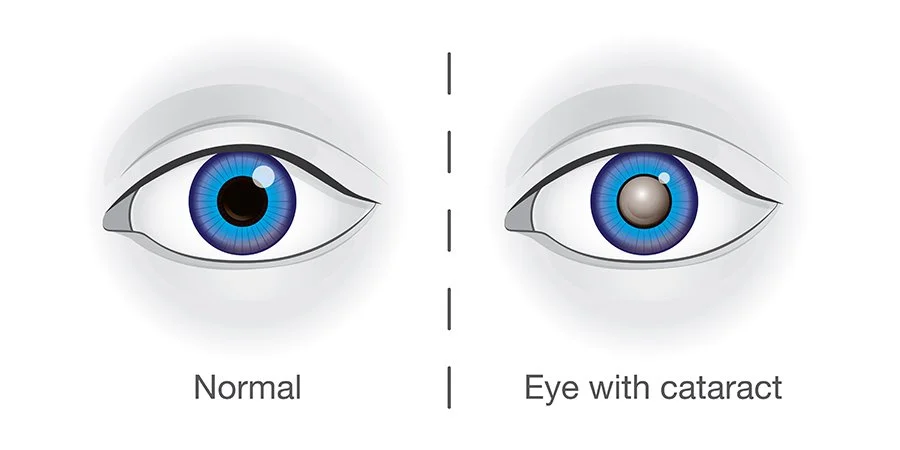Cataracts
Cataract
A cataract is a cloudy or opaque area in the normally clear lens of the eye. Depending upon its size and location, it can interfere with normal vision.
Most cataracts develop in people over age 55. They occasionally occur in infants and young children or as a result of trauma or medications. Usually, cataracts develop in both eyes, but one may be worse than the other.
The lens is located inside the eye behind the iris, the colored part of the eye. Normally, the lens focuses light on the retina, which sends the image through the optic nerve to the brain. However, if the lens is clouded by a cataract, light is scattered so the lens can no longer focus it properly, causing vision problems. The lens is made of mostly proteins and water. The clouding of the lens occurs due to changes in the proteins and lens fibers.
Types of cataracts
The lens is composed of layers, like an onion. The outermost is the capsule. The layer inside the capsule is the cortex, and the innermost layer is the nucleus. A cataract may develop in any of these areas. Cataracts are named for their location in the lens:
A nuclear cataract is located in the center of the lens. The nucleus tends to darken with age, changing from clear to yellow and sometimes brown.
A cortical cataract affects the layer of the lens surrounding the nucleus. The cataract looks like a wedge or a spoke.
A posterior capsular cataract is found in the back outer layer of the lens. This type often develops more rapidly.
Causes & risk factors
Most cataracts are due to age-related changes in the lens of the eye that cause it to become cloudy or opaque. However, other factors can contribute to cataract development, including:
Diabetes mellitus. People with diabetes are at higher risk for cataracts.
Drugs. Certain medications are associated with cataract development. These include corticosteroids, chlorpromazine and other phenothiazine related medications.
Ultraviolet radiation. Studies show an increased chance of cataract formation with unprotected exposure to ultraviolet (UV) radiation.
Smoking. There is possibly an association between smoking and increased lens cloudiness.
Alcohol. Several studies show increased cataract formation in patients with higher alcohol consumption compared with people who have lower or no alcohol consumption.
Nutritional deficiency. Although the results are inconclusive, studies suggest an association between cataract formation and low levels of antioxidants (for example, vitamin C, vitamin E, and carotenoids).
Family History. If a close relative has had cataracts, there is a higher chance of developing a cataract.
Symptoms
Cataracts generally form very slowly. Signs and symptoms of a cataract may include:
Blurred or hazy vision.
Reduced-intensity of colors.
Increased sensitivity to glare from lights, particularly when driving at night.
Increased difficulty seeing at night.
Change in the eye's refractive error, or eyeglass prescription.
Diagnosis
Cataracts are diagnosed through a comprehensive eye examination. Further testing may be needed to determine how much the cataract is affecting vision and to evaluate whether other eye diseases may limit vision following cataract surgery.
Treatment
Cataract treatment is based on the level of visual impairment they cause. If a cataract minimally affects vision, or not at all, no treatment may be needed. Patients may be advised to monitor for increased visual symptoms and follow a regular check-up schedule. In some cases, changing the eyeglass prescription may provide temporary vision improvement. In addition, anti-glare coatings on eyeglass lenses can help reduce glare for night driving.
When a cataract progresses to the point that it affects a person's ability to do normal everyday tasks, surgery may be needed. Cataract surgery involves removing the lens of the eye and replacing it with an artificial lens. The artificial lens requires no care and can significantly improve vision. Some artificial lenses have the natural focusing ability of a young healthy lens. Once a cataract is removed, it cannot grow back.
Cataract surgery is one of the safest and most effective types of surgery performed in the United States today. Approximately 90% of cataract surgery patients report better vision following the surgery.
Prevention
There is no treatment to prevent or slow cataract progression. While there are no clinically proven approaches to preventing cataracts, simple preventive strategies include:
Reducing exposure to sunlight through UV-blocking lenses.
Decreasing or stopping smoking.
Increasing antioxidant vitamin consumption by eating more leafy green vegetables and taking nutritional supplements.
Researchers link nutrients such as lutein and zeaxanthin, vitamin C, vitamin E and zinc to reducing the risk of certain eye diseases, including cataracts.



